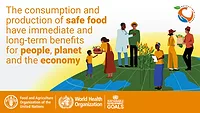The State of Food Safety in China

The Chinese government recently shone a light on the state of food safety within its borders. Alongside the release of a proposed a timeline and roadmap for China’s domestic food safety strategy, the China National Center for Food Safety Risk Assessment (NCFRA) has published a research paper that examines China’s concept of food safety and what is required to advance the nation’s food safety systems.
The proposal was announced in response to the World Health Organization’s (WHO’s) updated Global Strategy for Food Safety (GSFS), which was adopted at the 75th Session of the World Health Assembly. The updated GSFS requests that member states of the United Nations take initiative to support the realization of food safety commitments made at the United Nations Food Systems Summit.
The China National Strategy for Food Safety (CNSFS) was proposed in 2016, which the newly released timeline and roadmap build upon. The core goal of CNSFS is to ensure that Chinese citizens can “eat safely with ease.” The timetable and roadmap include four main benchmarks:
- The achievement of zero tolerance of systemic food safety risks by 2020, with constant improvement of Chinese levels of food safety assurance
- The establishment of a strict, efficient, and socially regulated food safety governance system by 2027
- Fundamental modernization of food safety governance and oversight of the food chain by 2035
- Full modernization of food safety governance throughout China by 2050, with China positioned as a leading nation for food safety standards and governance internationally.
Alongside the proposal of a timeline and roadmap for CNSFS, an NCFRA official raised concerns about certain aspects of the updated GSFS, which sets forth metrics to be used as indicators of progress. The NCFRA representative cautioned WHO about the use of diarrheal disease incidence as an indicator, stating that there is a lack of data for diarrheal disease incidence in China. Although China is working toward the implementation of a surveillance system for diarrheal disease incidence, the NCFRA representative maintained that using surveillance data as a way to compare progress between countries could reflect each nation’s scientific capabilities more than the desired metric. The NCFRA representative also raised the concern that some countries may not want to share data out of fear of the potential trade implications.
While the roadmap and timeline for CNSFS promise future improvements for Chinese food safety systems, an NCFRA paper published in the Chinese Journal of Preventive Medicine examines the specific work that must be done to make CNSFS goals a reality. According to the paper, several hurdles must be overcome to advance China’s food safety systems: China’s archaic food production structures, the nation’s vast geographic territory, and the uneven development of China’s agriculture and food industries.
The paper establishes two schools of thought within China’s developing food safety sector. The “risk-based” approach aims to prevent food safety incidents based on levels of risk, while the “hazard-based” approach connotes a prevention strategy based on the hazards themselves. The chosen approach affects the prioritization of issues that need to be solved. The paper states that, to further improve the level of food safety in China, it is critical to reach a national consensus on the concept of, and the best approaches to, food safety.
Looking for quick answers on food safety topics?
Try Ask FSM, our new smart AI search tool.
Ask FSM →









